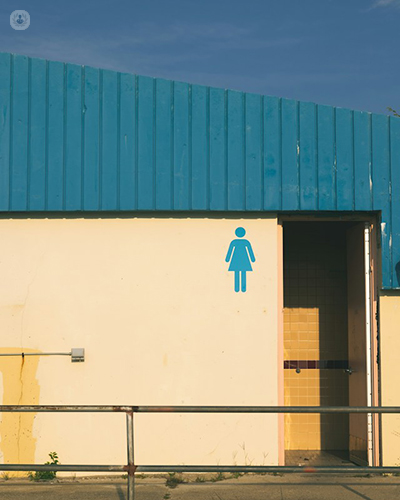Female incontinence: Common causes, management strategies and treatment
Written by:Incontinence can greatly affect a person’s quality of life and self-confidence. Fortunately, with specialist advice, many women are able to find effective management strategies and treatment for incontinence. In this informative guide, we learn more about the most common type of incontinence affecting women, as well as the available treatment options and most effective management techniques, from highly respected consultant urological surgeon Mr Rono Mukherjee.

What are the most common types of female incontinence?
Female incontinence is defined as the involuntary or unintentional leakage of urine. As urologists, we typically divide incontinence into three types:
- urge incontinence
- stress incontinence
- mixed incontinence
Urge incontinence is defined as leakage following an uncontrollable, sudden and intense sensation that is difficult to defer until going to the toilet. Stress incontinence, on the other hand, is leakage after physical movement or activity, such as sneezing, laughing, running, lifting a heavy object or trampolining, (i.e. any activity that puts pressure on the bladder). It’s also possible to experience mixed incontinence, where perhaps one form is more predominant than the other. Whichever the type, incontinence can have a massive impact on quality of life.
What are the causes of female incontinence?
Stress urinary incontinence happens with activity. The urethra is a tube that carries urine out of the bladder and also acts as a sort of valve. The muscles that support the urethra, known as the pelvic floor, can weaken with time. This weakness is associated not only with urinary incontinence, but also prolapse and faecal incontinence.
Urge incontinence is difficult to defer and is related to an overactive bladder. The bladder muscle, known as the detrusor muscle, can contract too often when the bladder fills up. Normally, when the bladder fills up with urine, we tell it to contract voluntarily when it's suitable to void. This is usually at a capacity of 350ml to 600ml and happens because we toilet train as infants. For some reason, with urge leakage, the muscle senses and contracts when the bladder is not particularly full and when we don't want it to do so. That gives us the sudden feeling that we need to pass urine and can't control it. Urge incontinence can be associated with caffeine and alcohol intake.
What are the treatment options for female incontinence?
With stress incontinence, the main form of treatment is initially conservative management. Losing weight can help, as can pelvic floor exercises when taught by a trained physiotherapist who supervises the training of the correct pelvic floor muscles. If this doesn’t prove beneficial after a period of time, we will then consider surgery.
To treat urge incontinence, patients can learn bladder retraining distraction techniques, such as counting backwards from 100. Another approach is to try and defer by looking at the clock for perhaps two minutes, then five and then ten, until the sensation associated with the bladder contracting dies down. In doing so, we can eventually store more urine and teach our bladder to hold on for a bit longer before we get another sensation to pass. The bladder muscle contracting comes like a wave and then eventually dies down. This training increases what we call our functional capacity, which can also be augmented with tablets if training doesn't work on its own.
Medication performs the same action - slowing the bladder down and preventing contractions. It can be very effective and is commonly prescribed by GPs and neurologists. There are two types of tablets:
- Anti-muscarinics, which have side effects including constipation caused by slowing down the bowel, dry mouth, and sometimes confusion in the elderly
- Beta three agonists, which have side effects such as nausea, headache, dizziness, and rarely palpitations
Although these medications do have some side effects, they are very commonly used. In the case that medication is ineffective, second line treatments could include Botox™ injections to the bladder, or a technique known as nerve stimulation, or percutaneous tibial nerve stimulation (PTNS).
What are the benefits and risks of treatment?
Every treatment has its side effects, which is why we begin with conservative means, so we can avoid the potential side effects of medication if possible. With urge incontinence, retraining the bladder, modifying fluid intake, reducing caffeine, alcohol, and also possibly citrus or acid type drinks, can be very beneficial.
For stress incontinence, avoiding surgery is obviously a good thing. Pelvic floor exercises should be taught by a physiotherapist, as simply by reading a leaflet, it can be difficult to train the right muscles. Losing weight and treating constipation can be very beneficial, particularly if you are straining, as this can weaken the pelvic floor. In addition, stopping smoking is important because smoking leads to coughing, which in turn can cause stress leakage.
Which lifestyle changes can be beneficial for women suffering from incontinence?a
For urge incontinence, fluid modification, including reducing caffeine and alcohol consumption, and avoiding citrus or acidic drinks is highly beneficial. For those suffering from stress incontinence, losing weight, treating constipation, and stopping smoking are key steps to help prevent and manage symptoms.
If you are suffering from incontinence and wish to schedule a consultation with Mr Mukherjee to discuss a treatment plan, visit his Top Doctors profile today.


